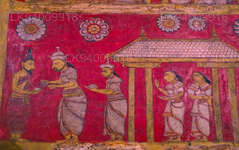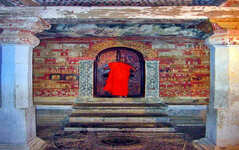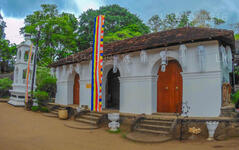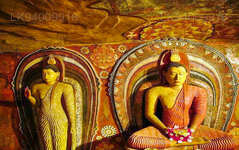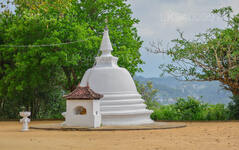
Kandy stad
Kandy, en pittoresk stad i centrala Sri Lanka, är känd för sitt rika kulturarv, sina livliga festivaler och sin vackra natur. Inbäddad bland frodiga kullar ligger Tandtemplet, ett UNESCO-världsarv, och erbjuder en fängslande blandning av historia och naturlig prakt.
Degaldoruwa Raja Maha Vihara
Amongst the rocky slopes and green valleys of rural Kandy lies a hidden treasure; the Degaldoruwa Raja Maha Vihara. This temple awes those who view it with its incredible Kandyan era frescoes. Construction of the temple began in the late 1770s under the reign of King Kirti Sri Rajasinha and was completed under the reign of his brother Rajadhi Rajasinha years later.
Legend
According to folklore a farmer was exploring the area and found a crevice between two rocks. On venturing into space he found a cave with a pile of golden sickles. The farmer was delighted with his discovery but feared retribution from some strange power. So he simply took only one sickle every morning and, after using it in his fields, returned it in the evening. His fields yielded an extremely healthy harvest and the farmer attributed it to the golden sickle. But then he became greedy. After all, he had been taking the sickles every day and there had been no ill effects, and there was a whole pile of them. So on the very last day of the harvest, he took two sickles instead of one and did not return one of them.
But unknown to the farmer, there had indeed been a guardian for the treasure. The guardian noticed the farmer taking the sickles, but kept quiet as he always returned them. On the day that the farmer took one sickle for himself, the guardian saw it at once and confronted him in his home. The terrified farmer immediately rushed to the crevice and returned the golden sickle that he had stolen. The guardian, who had been disappointed, then sealed the crevice by fusing the two rocks together. However, the villagers got to know this story and informed the king, Kirti Sri Rajasinha; who then ordered that the cave be found and a temple erected in it.
The Structure
- The temple is hollowed out of a 40 foot rock outcrop extending a natural cave. It consists of an elegant rock shelter with two roofed antechambers in front; a drummers’ hall and an image house; and the main shrine room cut into the rock itself. The two antechambers are constructed outside the rock outcrop and have wooden roofs.
- The architecture is unusual for the period as the drummers’ hall is not usually attached to the main temple.
- The image house is located through a set of old wooden doors, situated under a carved wooden Dragon Arch. It preserves a moonstone and a sequence of elaborate and colorful paintings showing scenes from four Jātaka tales, which tell the stories of the previous lives of Buddha.
- The door of the shrine room is banded with metal and once had jewels embedded within it. The inner walls of the shrine are completely covered in paintings; including the door.
- In addition to this main structure, there is a bo tree and a stupa on a plateau on the summit of the rocky outcrop above the temple. They can be reached by stairs carved into the temple.
The Frescoes
The paintings of Degaldoruwa, which are supposed to be some of the best of the Kandyan era, are believed to be the work of four ‘Sittara’ artists. The finest of these paintings grace the ceiling of the temple; ‘Mara Yudde’, an artistic depiction of Buddha’s internal spiritual battle against Māra, the demon of death, rebirth, and desire.
The murals are unique in that all the elements; the people, the trees and the animals; are a uniform size and only the front views of ]people are shown. The trees have a stylized form, with their branches and leave spreading out to either side. The individual elements, such as the adornments on the elephants and the uniforms of the attendants, are portrayed in great detail. All of the colors used by the artists in the murals were created from the barks
Om Kandy-distriktet
Kandy-distriktet ligger i den centrala provinsen i Sri Lanka. Kandy, ett av Sri Lankas sju världsarv, var en gång hem för Kandy-kungarna på 1500-talet och en källa till all musik, konst, hantverk och kultur i landet. Kandy ligger cirka 129 km från Colombo och ligger i en kuperad terräng och alla blickar dras till stadens centrum, där Kandysjön utgör ett charmigt inslag. Kandy har fortfarande stor religiös betydelse för Sri Lanka, eftersom det är i denna charmiga stad som Dalada Maligawa eller "Tandtemplet" ligger, i vilket Buddhas heliga tandrelik ligger välbevakad. Den kungliga botaniska trädgården i Peradeniya ligger cirka 5 km väster om stadens centrum i Peradeniya och besöks av 1,2 miljoner människor per år. Det är den största botaniska trädgården på ön. Udawatta Kele (Udawatta-skogen) är ett skyddat fristadsområde beläget i hjärtat av staden, strax norr om Tandtemplet. Kandy är en stad med majoritets singalesiska invånare; det finns stora samhällen som tillhör andra etniska grupper, såsom morer och tamiler. Kandy är näst efter Colombo, centrum för Sri Lankas ekonomi. Många större kooperativ har stora filialtjänstemän i Kandy och många industrier, inklusive textilier, möbler, informationsteknik och smycken, finns här. Många jordbruksforskningscentra finns i staden. Och en källa till all musik, konst, hantverk och kultur i landet. Cirka 129 km från Colombo ligger Kandy inbäddat i en kuperad terräng och alla blickar dras till stadens centrum, där Kandysjön utgör ett charmigt inslag. Kandy har fortfarande stor religiös betydelse för Sri Lanka, eftersom det är i denna charmiga stad som Dalada Maligawa eller Tandtemplet ligger, inom vilket Buddhas heliga tandrelik ligger välbevakad.
Om Centralprovinsen
Centralprovinsen i Sri Lanka består huvudsakligen av bergig terräng. Provinsen har en yta på 5 674 km² och en befolkning på 2 421 148. Några större städer inkluderar Kandy, Gampola (24 730), Nuwara Eliya och Bandarawela. Befolkningen är en blandning av singaleser, tamiler och morer. Både bergshuvudstaden Kandy och staden Nuwara Eliya ligger inom Centralprovinsen, liksom Sri Pada. Provinsen producerar mycket av det berömda ceylonteet, som planterades av britterna på 1860-talet efter att en förödande sjukdom dödat alla kaffeplantager i provinsen. Centralprovinsen lockar många turister, med bergsstäder som Kandy, Gampola, Hatton och Nuwara Eliya. Tempeltand eller Dalada maligawa är den viktigaste heliga platsen i Centrelprovinsen. Klimatet är svalt, och många områden på cirka 1500 meters höjd har ofta kyliga nätter. De västra sluttningarna är mycket våta, och vissa platser har nästan 7000 mm regn per år. De östra sluttningarna är delar av den mellantorra zonen eftersom det endast regnar från nordöstra monsunen. Temperaturerna varierar från 24 °C i Kandy till bara 16 °C i Nuwara Eliya, som ligger 1 889 m över havet. De högsta bergen i Sri Lanka ligger i Centralprovinsen. Terrängen är mestadels bergig, med djupa dalar som skär in i den. De två huvudsakliga bergsregionerna är det centrala massivet och Knuckles-bergskedjan öster om Kandy.


